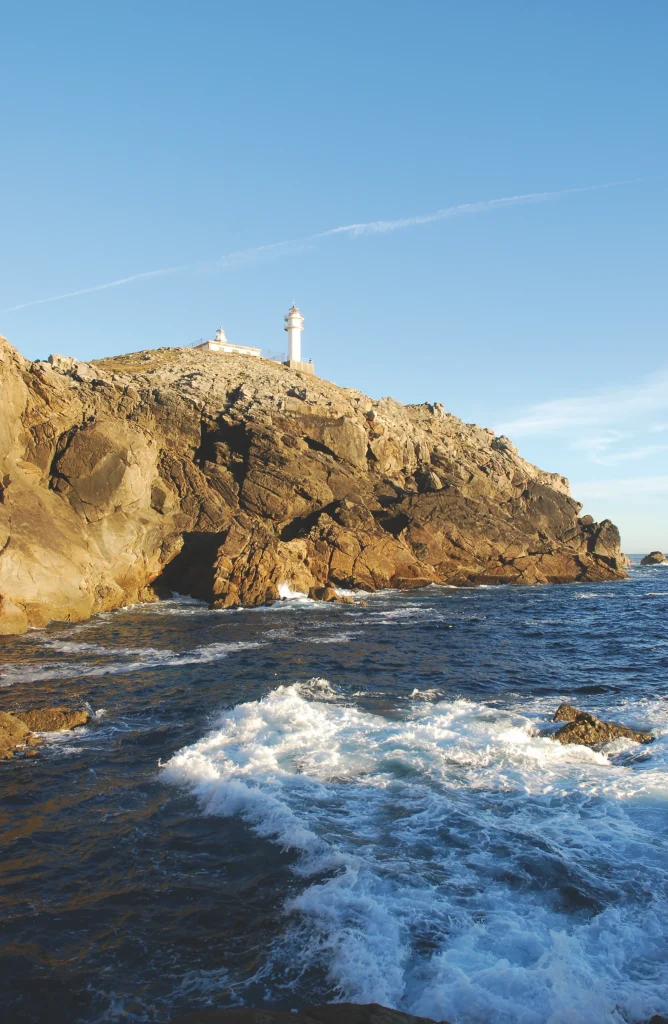
Costa da Morte is the westernmost coastal region of Galicia, and the point where the Iberian Peninsula and the European continent also come to an end. A large territory that makes up one fifth of the province of Coruña, it includes the regions of Bergantiños, Terra de Soneira and Fisterra (previously Nemancos), and the municipalities of Mazaricos and Carnota. The name of the region is a relatively recent one and was given because of the many ships that sank in this part of the coast in the late 19th century.
The territory is defined more than anything by its extensive coastline, shaped by spectacular cliffs in the areas most exposed to the sea, “this proud, restless, powerful and tireless sea”, in the words of the local poet López Abente, alternating with long beaches and small estuaries or rías. A unique coast on which the tremendous power of nature has left an indelible mark, creating a heritage of extraordinary value.
From the coast, the influence of the sea penetrates further inland via the Anllóns, Porto, Castro and Xallas rivers. The banks of these rivers are home to some of the best preserved native forestland in the region. Fertile valleys with their “sweet meadows”, in the words of the poet Eduardo Pondal.
This westernmost region of Eurasia has been populated since time immemorial, many traces of which remain from the Neolithic period to the present day.
The earliest remains belong to the megalithic period, characterised by barrows and dolmens that were used as burial sites. The Castro culture was the next to leave its mark, with its unique circular fortified settlements. Many of these hillforts can be found in the region.
Costa da Morte was no stranger to Romanisation. Brandomil, Moraime and Tines are settlements where the Roman presence is most evident. With the arrival of Christianity came the first religious inscriptions in Galicia—the stele of Victorinus, found in Tines, dates back to the late 4th century. No large religious communities were founded in this region, but there were some small monasteries. A notable heritage left by the clergy still remains.
Alongside the religious communities, noble families began to make their presence felt in the region. The Trabas family was the first to settle here, followed by the Mariños de Lobeira, Moscosos de Altamira, Bermúdez de Castro, Rioboos and Pardiñas. Their presence is made visible in the form of magnificent buildings such as the castle of Vimianzo, the Torres do Allo, the Torres de Mens and the manor house of Vilardefrancos. The region is also full of local popular architecture: hórreos (granaries), cruceiros (calvaries) and windmills are just some of the most visible examples. It is also home to a wealth of intangible heritage, especially legends about the natural world, saints and historical remains.
The cuisine of Costa da Morte is rightly famous and one of its major attractions thanks to a wide and varied selection of coastal and inland products that provide an abundance of raw materials to make a wide range of delicious dishes. The sea offers the very best seafood while the land produces delicious meats and vegetables, which, combined with a local cuisine based on maintaining the original flavours of the ingredients, make for a truly delicious cuisine.
The Guide to Costa da Morte sets out to offer visitors the chance to discover and enjoy the rich heritage of this region. It contains a set of routes that take you on journeys where you can experience the best that this land has to offer.
The guide is divided into two sections: the first is about the context of the region, with details about the origin of the name of Costa da Morte, and geographical features such as the landscape, climate, flora and fauna, the people, its economic resources, without forgetting its history and wonderful cuisine.
The second, and longer, section offers visitors a series of routes throughout the region for travellers on foot or by car. If you plan to visit the area in a vehicle, we offer six routes across the 17 municipalities of Costa da Morte, in which you can visit all the locations with most natural, scenic, historical and cultural value. Most of the routes are circular, so travellers can start at any point. Each one has been designed for one day and tourists can decide for themselves to choose the stopping points that best suit their interests.
If you plan to go on foot, there is a selection of short and long routes, some of which immerse visitors even deeper into the region, especially spaces where nature and history come together to offer an even richer experience. We offer 13 shorter routes on foot in one day, and two longer ones: the Camiño dos Faros and the Way of Saint James of Fisterra and Muxía, which can be completed in a few days.
The Guide offers you all the information you need to get closer to Costa da Morte from a wide variety of perspectives and interests, so that you can discover and get a deeper insight into the geography and history of the region. It then offers a range of places and things you can choose from to see and experience the region according to how much time you have and what your interests are. A simple but very useful guide for any visitor who wants to come here and organise a trip that caters to their tastes.